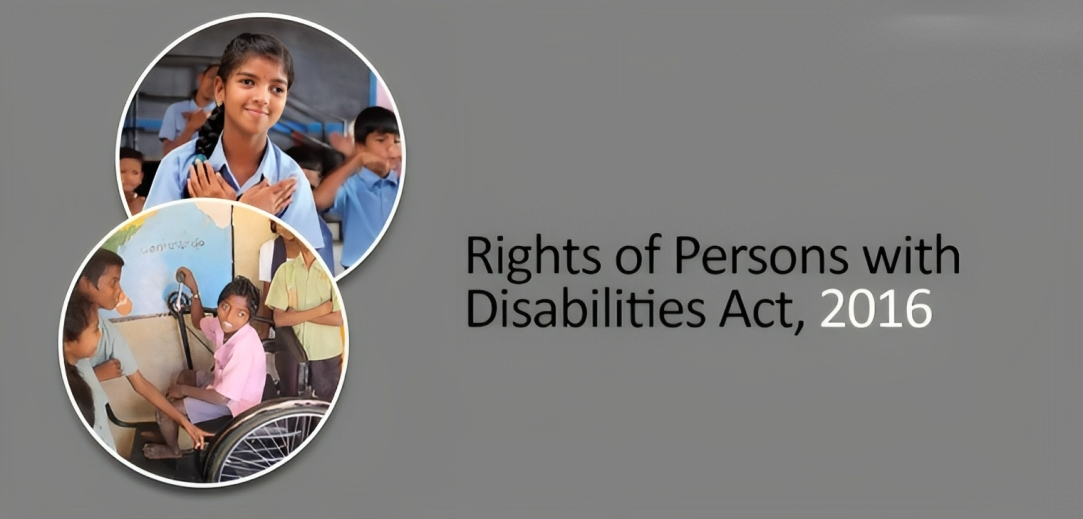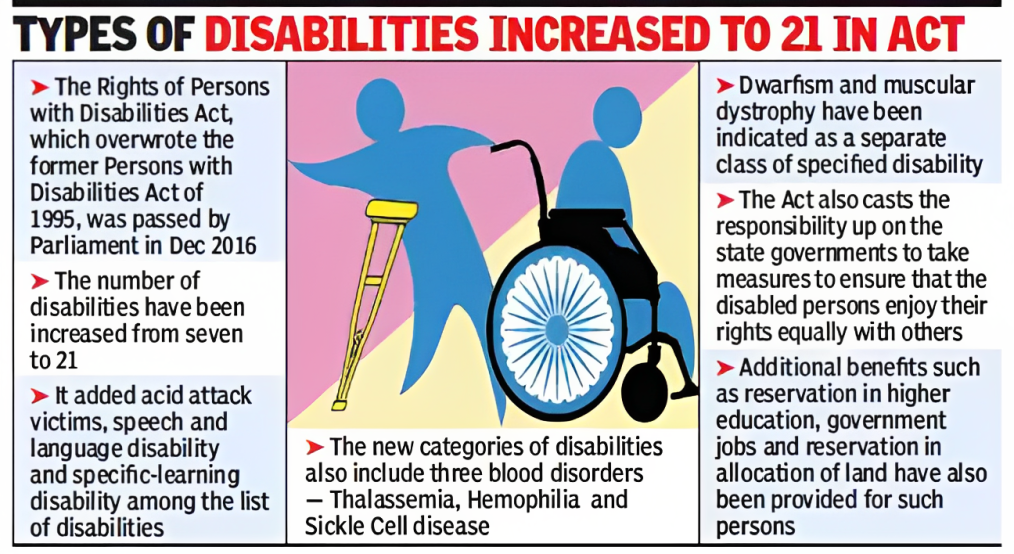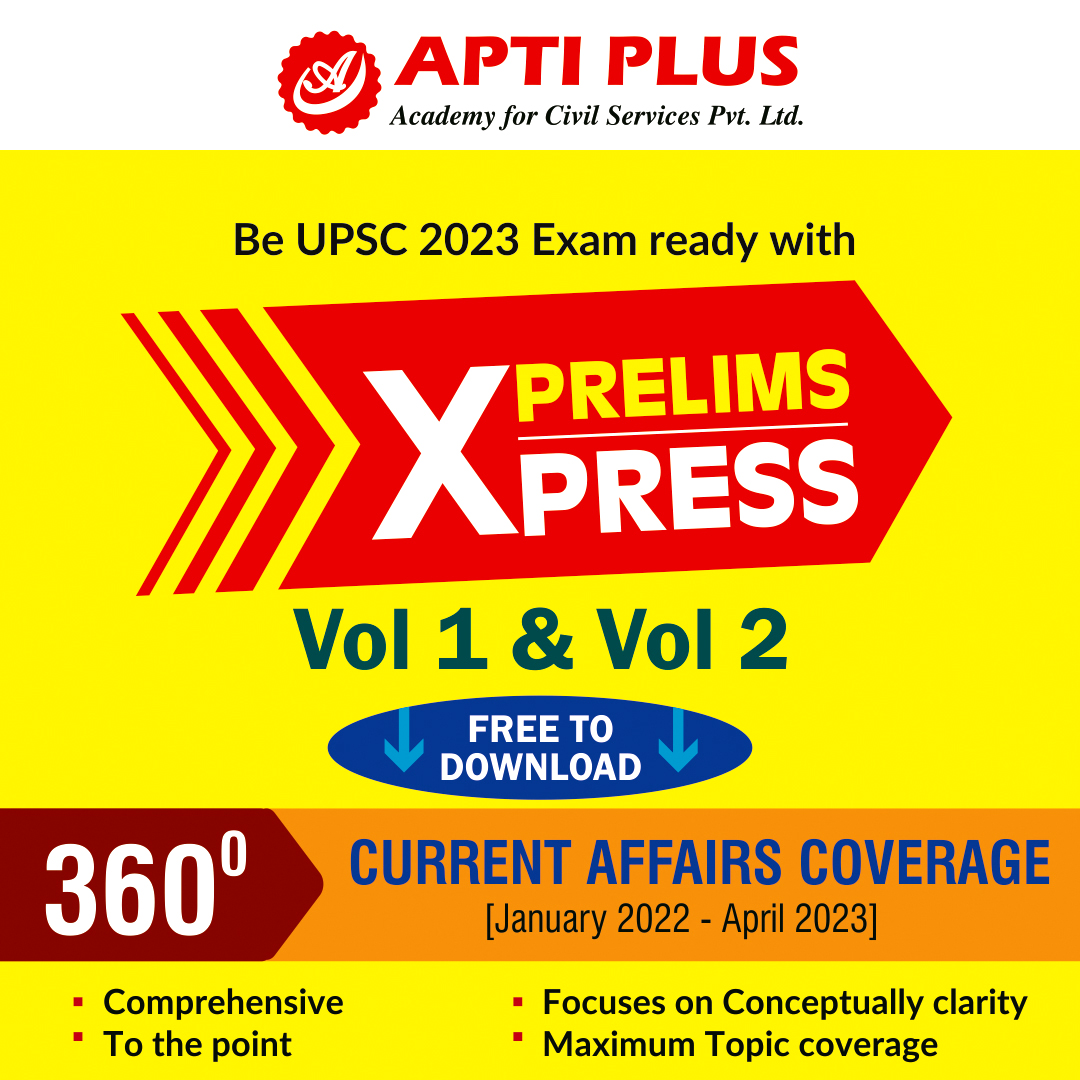
Copyright infringement not intended
Context: The Department of Empowerment of Persons with Disabilities (DEPwD) has launched a series of reforms to implement the terms of the "Rights of Persons with Disabilities Act 2016" and to empower people with disabilities.
Details
- The Department of Empowerment of Persons with Disabilities (DEPwD) has started a series of meetings with all states/UTs and their representatives to discuss reforms for implementing the provisions of the "Rights of Persons with Disabilities Act 2016" and empowering people with disabilities.
Rights of Persons with Disabilities Act 2016
About
- The Act was passed by the Parliament of India to give effect to the United Nations Convention on the Rights of Persons with Disabilities (UNCRPD), which India ratified in 2007.
- The Act replaces the earlier Persons with Disabilities (Equal Opportunities, Protection of Rights and Full Participation) Act, 1995, which was considered inadequate and outdated in addressing the needs and challenges of persons with disabilities in India.

Definition and Classification of Disabilities
- One of the major changes introduced by the Act is the expansion of the definition and classification of disabilities.
- The Act recognises 21 types of disabilities, as compared to 7 types under the previous law. These are:
- Blindness, Low-vision, Leprosy cured persons,
- Hearing impairment (deaf and hard of hearing), Locomotor disability, Dwarfism,
- Intellectual disability, Mental illness, Autism spectrum disorder,
- Cerebral palsy, Muscular dystrophy, Chronic neurological conditions,
- Specific learning disabilities, Multiple sclerosis, Speech and language disability,
- Thalassemia, Hemophilia, Sickle cell disease,
- Multiple disabilities including deafblindness, Acid attack victim, and Parkinson's disease.
- It empowers the central government to notify any other category of specified disability.
- It defines a person with a disability as a person with a long-term physical, mental, intellectual or sensory impairment which, in interaction with barriers, hinders his full and effective participation in society equally with others.
- It defines a person with benchmark disability as a person with not less than 40% of a specified disability where a specified disability has not been defined in measurable terms and includes a person with a disability where a specified disability has been defined in measurable terms, as certified by the certifying authority.
- It recognises persons with disabilities have high support needs and need intensive support from others for their daily activities.

Rights and entitlements for persons with disabilities
Equality and non-discrimination
- The Act prohibits discrimination based on disability and mandates equal protection and opportunities for persons with disabilities in all spheres of life.
Women and children with disabilities
- The Act recognizes the special needs of women and children with disabilities and provides for measures to ensure their safety, health, education and participation in decision-making.
Community life
- The Act promotes the right of persons with disabilities to live independently and be included in the community.
- It also provides for the establishment of community-based rehabilitation programs and services.
Protection from abuse, violence and exploitation
- The Act provides for mechanisms to prevent and redress any abuse, violence or exploitation against persons with disabilities. It also mandates the reporting of such cases to the authorities.
Accessibility
- The Act mandates accessibility of physical environment, transportation, information and communication technology, consumer goods and services for persons with disabilities.
- It also sets time limits for making existing infrastructure and premises accessible and provides penalties for non-compliance.
Education
- The Act provides for free and compulsory education for children with benchmark disabilities (those with at least 40% of a specified disability) up to the age of 18 years.
- It also provides for the reservation of seats in higher educational institutions and scholarships for students with disabilities.
Employment
- The Act provides for the reservation of posts in government establishments for persons with benchmark disabilities.
- It also provides incentives to employers in the private sector who employ persons with disabilities.
- It also mandates the formulation of an equal opportunity policy by every establishment and the appointment of a grievance redressal officer.
Social Security
- The Act provides for various schemes and programs for social security, health care, rehabilitation and recreation of persons with disabilities.
- It also provides for insurance schemes for their benefit.
Government responsibility
- The Act mandates the appropriate governments (Central and State) to take various measures to implement the provisions of the Act, such as awareness campaigns, accessibility norms, human resource development and social audit.
- The Act imposes various duties and obligations on the central and state governments, local authorities and private entities to ensure that persons with disabilities enjoy their rights without any barriers. These include:
- Providing reasonable accommodation
- Making public buildings and transport accessible
- Providing accessible information and communication
- Providing assistive devices and technologies
- Providing rehabilitation services
- Promoting awareness and sensitization
- Collecting disaggregated data on disability
- Establishing grievance redressal mechanisms

Establishment of various institutions and authorities to implement its provisions
Central Advisory Board on Disability
- This is a statutory body that advises the Central Government on policies and programs relating to disability.
- It consists of representatives from various ministries, state governments, experts, organizations and persons with disabilities.
State Advisory Boards on Disability
- These are bodies at the state level that advise the state governments on disability matters.
District-level Committees
- These are committees at the district level that monitor the implementation of the Act and assist the state governments in its enforcement.
Chief Commissioner for Persons with Disabilities
- This is a central authority that coordinates the work of state commissioners, monitors the utilization of funds, safeguards the rights of persons with disabilities and redresses their grievances.
State Commissioners for Persons with Disabilities
- These are state-level authorities that perform similar functions as the chief commissioner within their respective states.
National Fund for Persons with Disabilities
- This is a fund that receives grants from various sources and utilizes them for the welfare of persons with disabilities.
Challenges and limitations
Lack of awareness and sensitization
- Lack of awareness and sensitization among the public, government officials, service providers and employers about the rights and needs of persons with disabilities.
Inadequate funds
- Inadequate allocation of funds and resources for the effective functioning of the Central and State Advisory Boards on Disability, the Chief Commissioner and State Commissioners of Persons with Disabilities, the National and State Funds for Persons with Disabilities, and other authorities and institutions established under the Act.
Delay in Implementation
- Delay in framing and notifying the rules, regulations, guidelines and schemes for operationalizing various provisions of the Act, such as reservation in education and employment, accessibility standards, certification of disability, guardianship, social security, etc.
Non-compliance and non-reporting
- Non-compliance and non-reporting by the appropriate governments and private entities on their obligations under the Act, such as ensuring accessibility of public buildings and transport, providing reasonable accommodation and assistive devices, conducting regular surveys on disability, etc.
Lack of coordination and convergence
- Lack of coordination and convergence among different ministries, departments and agencies at the central and state levels for implementing cross-cutting issues related to disability, such as health, education, skill development, employment, social welfare, etc.
Absence of grievance redressal mechanism
- Absence of a robust grievance redressal mechanism and monitoring system for addressing the complaints and violations of rights of persons with disabilities under the Act.
Low participation and representation
- Low participation and representation of persons with disabilities and their organizations in the policy-making and decision-making processes related to disability issues.
Steps need to be taken
Creating awareness
- Creating awareness and sensitization campaigns on the provisions and benefits of the RPwD Act among all sections of society, especially among persons with disabilities and their families, through various media platforms, workshops, seminars, etc.
Allocate adequate resources
- Enhancing the allocation of funds and resources for the effective implementation and enforcement of the RPwD Act at all levels, and ensuring timely utilization and audit of the same.
Fast implementation
- Expediting the framing and notifying of the rules, regulations, guidelines and schemes for operationalizing various provisions of the RPwD Act, and ensuring their dissemination and compliance by all concerned authorities and entities.
Strengthening the capacity
- Strengthening the capacity and accountability of the Central and State Advisory Boards on Disability, the Chief Commissioner and State Commissioners of Persons with Disabilities, and other authorities and institutions established under the RPwD Act, by providing them adequate staff, infrastructure, training, etc.
Establishing a robust grievance redressal mechanism
- Establishing a robust grievance redressal mechanism and monitoring system for addressing the complaints and violations of rights of persons with disabilities under the RPwD Act, by setting up special courts or designated authorities at the district level or below.
Promoting coordination and convergence
- Promoting coordination and convergence among different ministries, departments and agencies at central and state levels for implementing cross-cutting issues related to disability through inter-ministerial committees or task forces.
Ensuring participation and representation
- Ensuring participation and representation of persons with disabilities and their organizations in the policy-making and decision-making processes related to disability issues through consultative meetings or platforms.
Conclusion
- The Rights of Persons with Disabilities Act, 2016 is a progressive and comprehensive law that reflects the principles of dignity, autonomy, inclusion and participation of persons with disabilities. It is expected to bring about a paradigm shift in the way disability is perceived and addressed in India. It also provides an opportunity for persons with disabilities to claim their rights and entitlements and contribute to the development of the nation.
|
PRACTICE QUESTION
Q. The Rights of Persons with Disabilities Act 2016 is a landmark legislation that aims to protect and empower the rights of persons with disabilities in India. The Act provides for various entitlements and benefits for persons with disabilities. However, the Act also faces several challenges in its implementation and enforcement. What are the main challenges and barriers that hinder its effective implementation? And what are the possible ways forward to overcome these challenges and ensure the full realization of the rights of persons with disabilities?
|

https://www.pib.gov.in/PressReleasePage.aspx?PRID=1922783





